RESEARCH CONDUCTED IN EASTERN DRY AGROCLIMATIC ZONE
TITLE OF THE STUDY: Estimation of Externalities due to Sand Mining in Water Streams in affected Riparian Areas of Karnataka.
POST GRADUATE STUDENT INVOLVED:
Smt. Hemalatha A.C.
email: achema@rediffmail.com
Preamble
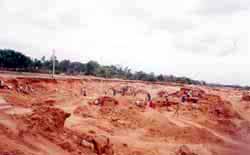 Riverbeds are source of sand, which is basic
raw material in construction activity. The layer of sand forms the spongy surface,
which enhances groundwater recharge. In recent years due to rapid urbanization
sand has been exploited in unsustainable manner, which has adverse impacts on
riparian areas. In Karnataka Department of Mines and Geology permitted mining
of sand along the riverbed of Uttara Pinakini. But the department could not
strictly monitor the mining of sand as a result sand has been mined more than
permitted level, which has adverse impact on riparian area. Sand mining is done
to a depth of 20 to 30 feet, so the study is undertaken along Uttara Pinakini
to estimate the impact of sand mining. This study estimates the externalities
due to mining on groundwater depletion, which effects the irrigation along the
river stream.
Riverbeds are source of sand, which is basic
raw material in construction activity. The layer of sand forms the spongy surface,
which enhances groundwater recharge. In recent years due to rapid urbanization
sand has been exploited in unsustainable manner, which has adverse impacts on
riparian areas. In Karnataka Department of Mines and Geology permitted mining
of sand along the riverbed of Uttara Pinakini. But the department could not
strictly monitor the mining of sand as a result sand has been mined more than
permitted level, which has adverse impact on riparian area. Sand mining is done
to a depth of 20 to 30 feet, so the study is undertaken along Uttara Pinakini
to estimate the impact of sand mining. This study estimates the externalities
due to mining on groundwater depletion, which effects the irrigation along the
river stream.
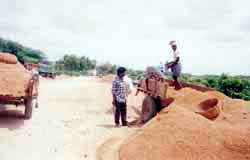 The major source of irrigation is groundwater
in the hard rock areas of Gowribidanur as river flow is seasonal and farmers
depend on borewells, open wells and filter point wells for irrigation. Sand
mining has resulted in groundwater depletion, which increased the well failure
in sand mining area.
The major source of irrigation is groundwater
in the hard rock areas of Gowribidanur as river flow is seasonal and farmers
depend on borewells, open wells and filter point wells for irrigation. Sand
mining has resulted in groundwater depletion, which increased the well failure
in sand mining area.
Objectives of the study
- Estimation of externalities due to sand mining in streams on crop pattern,
groundwater resources and farm economy
- Estimation of the demand function for sand for civil works.
- Documentation of the travails of farmers and stakeholders from sand mining
Major Findings of the study
- Groundwater depletion is the main impact occurred due to sand mining. The
proportion of non-functional bore wells (12 percent), filter point wells (23
percent) and open wells (56 percent) were lower in non-sand mining areas compared
with non-functional bore wells (21 percent), filter point wells (68 percent)
and open wells (100 percent) in sand mining area.
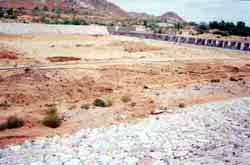
- The effect on agricultural income is reflected on net returns per acre in
sand mining and non-sand mining areas. The net return per acre is Rs. 3880
and Rs. 12,316 respectively for rainfed and irrigated in non-sand mining areas.
The net return per acre in sand mining area is Rs. 2380 and Rs 9992 respectively
for rainfed and irrigated areas.
- The net return per acre under open wells is Rs 10605 and Rs 0 in non-sand
mining and sand mining areas respectively. The net returns per acre under
filter point wells are Rs. 6635 and Rs.14147 in sand mining and non-sand mining
areas respectively. The net return per acre under bore well irrigation is
Rs. 9992 and Rs 12170 respectively in sand mining and non-sand mining area.
- In water and labour intensive crops, the net return per acre is high in
non-sand mining area compared to sand mining area. In crops like paddy, sugarcane,
banana the net returns per acre is Rs. 5513, Rs, 22811 and Rs. 23850 respectively
in non-sand mining areas as against Rs. 2572, Rs. 15500 and Rs. 15468 respectively
in sand mining areas. The net return per acre from all crops is 18 percent
high in non-sand mining areas compared to sand mining area.
- The net returns per acre was 53 percent and seven percent lower among filter
point wells and bore wells respectively in sand mining area compared to non-sand
mining area. After considering proportion of well failure the net returns
per acre was lower by 79 percent and 11 percent respectively among filter
point wells and bore wells respectively in sand mining area compared to non-sand
mining area. Further when net returns per acre discounted considering the
average age, the net returns per acre was lower by 89 percent and 19 percent
respectively among filter point wells and bore wells respectively in sand
mining area compared to non-sand mining area.
- Agriculture is the main source of income (60 per cent) followed by sericulture
(21 per cent) in non-sand mining areas whereas in sand mining areas sand mining
activity is the main source of income (59 per cent) followed by agriculture
(31 per cent).
- Based on activities followed farmers were characterized into different categories.
About 42 per cent farmers belong to agriculture + labour + mining category
and earn net income per acre Rs 57823 followed by agriculture + labour +sericulture
category and earn net income of Rs.52288 in sand mining areas.
- In non sand mining area about 46 percent of farmers depend on agriculture
+ livestock category and their net income per acre is Rs 13441, where as 37
per cent farmers belong to agriculture +labour + sericulture and earn net
income per acre is Rs. 31295 followed by 17 per cent of farmers agriculture
+ labour + other activities category and they earn net income per acre Rs.20491.
- The proportion of filter point well failure is 152 per cent more in sand
mining area compared to non-sand mining area. Irrigation cost per acre-inch
of groundwater used from filter point wells is Rs. 312 and Rs 146 respectively
in sand mining and non-sand mining areas respectively.
- Among bore wells the proportion of failure is 36 per cent more in sand mining
area as compared to non-sand mining areas. Irrigation cost per acre-inch of
groundwater used is Rs.307 and Rs 109 respectively in sand mining and non-sand
mining areas. Net returns per rupee of irrigation cost are Rs.5.0 and Rs.10.3
respectively in sand mining and non-sand mining areas.
- The proportion of well failure of open wells is 100 percent and 52 percent
respectively in sand mining and non-sand mining areas.
- Irrespective of wells, the proportion of well failure is 53 per cent high
in sand mining compared to non-sand mining areas. The irrigation cost per
acre-inch of groundwater used is Rs. 309.5 and Rs 133 respectively in sand
mining and non-sand mining areas. The net return per rupee of irrigation cost
is Rs. 4.32 and Rs.11.88 respectively in sand mining and non-sand mining area.
- Economics of irrigation and distance from streams in sand mining and non-sand
mining areas. In sand mining areas the proportion of well failure (0.68 to
0.19) declines as they move away from stream whereas in non-sand mining areas
there is no variation in proportion of well failure (0.33 to 0.23).
- Irrigation cost per acre of GIA decreases from Rs. 861 to Rs 332 in sand
mining areas as against Rs. 173 to Rs. 127 in non-sand mining areas as the
distance of wells increases from river streams. Negative externality incurred
due to investment on additional wells reduces from Rs. 7080 to Rs. 1585 whereas
in non-sand mining areas it increases from Rs. 1394 to Rs. 1462.
- When we consider before and after situation in sand mining areas, the water
yield has declined by 36 percent among filter point wells and 35 percent among
bore wells. The number of filter point wells and bore wells reduced by 65
percent and 21 percent respectively in sand mining area.
- Around 20 per cent of farmers in sand mining areas provide road linkage
for transporting sand. The net return per acre from providing road linkage
is Rs.2581 after amortizing for three years at the rate of two percent.
- When externality is considered, the net return in sand mining area was minus
Rs.771 per acre, whereas without considering externalities the net returns
accounts to Rs.6250. This apparently indicates that farmers are enjoying pseudo
illusionary return of Rs.6250 per acre, while they are in fact losing Rs.711
per acre due to sand mining externality.
- The estimated demand function for sand in Bangalore city indicates that
demand of sand is price inelastic. For every 1 per cent increase in price
the quantity demanded decreases by 0.87 per cent.
- On average sand transporters will supply 25 loads per month realizing a
gross return of Rs.4200 per load and net return of Rs.835 per load.
Implications
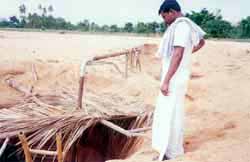
- Groundwater is crucial source for the farmers in Gowribidanur taluk to eak
out the living since there is no any perennial source of irrigation. Currently
the irrigation wells in the riparian areas of Uttara Pinakini are seriously
threatened due to excessive sand extraction, which in turn affects the groundwater
recharge. This had led to increase in proportion of well failure.
- Net returns per well in sand mining is 41 percent lower compared to non-sand
mining area. The net return per rupee of amortized cost of irrigation is 63
percent lower in sand mining compared to non-sand mining area.
- This study has amply demonstrated that distance from river stream plays
a crucial role in degree of functioning wells. The proportion of well failure
(0.52) within 120 feet in sand mining is 36 percent higher compared to non-sand
mining area. Therefore it is imperative that sand mining is seriously (negative
externality) affecting the interests of the economy of riparian farmers along
the Uttara pinakini basin. This calls for a serious, effective and efficient
implementation of regulation of sand mining for the benefit of both agriculture
and civil works.
- Currently the sand extraction is permitted up to three feet by paying a
royalty of Rs.45 per truckload of sand to the Department of Mines and Geology,
however, sand miners are excavating even up to 40 feet in Uttara pinakini
stream. Thus department of mines and geology has to seriously monitor the
sand mining activity for the overall benefit of society.
- The estimated negative externality per irrigation well in the Gowribidanur
sand mining area was Rs. 4186 per year. There are about 8000 irrigation wells
located in the riparian areas of the Gowribidanur river stream, where sand
mining is actively being undertaken. Thus, the total estimated negative externality
was Rs.3,34,88,000. The total estimated sand accumulated in uttara pinakini
river stream is 1,74,00,000 cubic meter in fifteen years, of which 61 percent
was extracted, constituting 1,06,14,000 cubic meter or 37,14,90,000 cft in
fifteen years. Therefore annual sand extracted is 2,47,66,000 cft imposing
externality of Rs 1.35 per cft or Rs .540 per load. In order to conserve the
sand resources along the riparian areas, the environmental cost Rs 540 per
load should be imposed to internalise the pressure on this natural resource
in the market price of sand.
This research is published in International Journal of Ecology & Development
(IJED)
Click here to Download this paper, M.G. Chandrakanth, A.C. Hemalatha & N. Nagaraj, (2004) , Estimation of Externalities
Due to Sand Mining in Water Streams in Affected Riparian Areas of Karnataka, International Journal of Ecology & Development (IJED), Vol.2, pp. 27-42.
RESEARCH CONDUCTED IN SOUTHERN DRY ZONE
TITLE OF THE STUDY: Estimation of
externalities due to use of polluted groundwater for irrigation in Kabini command,
Karnataka
POST GRADUATE STUDENT INVOLVED:
Smt. Varuni C.N.
email: varuni_cn@rediffmail.com
Preamble
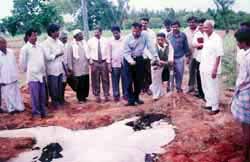 During
the grant period covered in this report, study on the effect of groundwater
pollution in irrigated agriculture is. In this study externalities due to use
of polluted groundwater for irrigation are estimated by covering the population
of all the 35 farmers who had irrigation wells which are affected by distillery
effluent pollution in the distillery effluent polluted villages (DEPA), comprising
Geekalli, Golur in Nanjangud taluk. For contrast, a sample of 35 farmers in
Devarasanahalli are covered as control. Major effect of groundwater pollution
is the downward shift in sugarcane area due to pollution to the tune of 60 percent.
In DEPA, all drinking water wells are abandoned and 22 percent of open wells
and eight percent of bore wells are abandoned. Farmers in DEPA (control village)
realized a net return per acre of Rs. 5489 (Rs. 10892), a reduction of 98 percent
due to use of distillery effluent polluted groundwater for irrigation, despite
this water being diluted from the Kabini surface water irrigation. The surface
water irrigation from Kabini is available only for the first six months from
Jan to June.
During
the grant period covered in this report, study on the effect of groundwater
pollution in irrigated agriculture is. In this study externalities due to use
of polluted groundwater for irrigation are estimated by covering the population
of all the 35 farmers who had irrigation wells which are affected by distillery
effluent pollution in the distillery effluent polluted villages (DEPA), comprising
Geekalli, Golur in Nanjangud taluk. For contrast, a sample of 35 farmers in
Devarasanahalli are covered as control. Major effect of groundwater pollution
is the downward shift in sugarcane area due to pollution to the tune of 60 percent.
In DEPA, all drinking water wells are abandoned and 22 percent of open wells
and eight percent of bore wells are abandoned. Farmers in DEPA (control village)
realized a net return per acre of Rs. 5489 (Rs. 10892), a reduction of 98 percent
due to use of distillery effluent polluted groundwater for irrigation, despite
this water being diluted from the Kabini surface water irrigation. The surface
water irrigation from Kabini is available only for the first six months from
Jan to June.
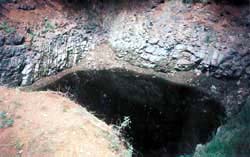 As
the net return from different crops in DEPA are far lower than in control village,
a few farmers in DEPA searched for new opportunities including off-farm income
by working in the distillery factory realizing Rs 11,142 per family. The off-farm
income was Rs. 3571 in control village. Due to exposure to distillery effluent
pollution of groundwater, an additional Rs 1432 was incurred towards health
expenditure per family per annum in DEPA. The net return per acre for farmers
located closer to (away from) lagoon and canal irrigation area was Rs. 4859
(Rs.6227), a reduction of 22 percent. Similarly the repair charges of pumpset
were Rs. 2500 (Rs. 937), an increase of 167 percent. These are distinct pointers
to the effect of distillery pollution effluents on agriculture. Net loss per
acre of paddy (sugarcane) in DEPA was Rs2656 (Rs. 16840). The DEPA farmers richly
deserve to be compensated for this loss to this extent by taxing the distillery
to the tune of Rupee 1 for every liter of ethyl alcohol produced.
As
the net return from different crops in DEPA are far lower than in control village,
a few farmers in DEPA searched for new opportunities including off-farm income
by working in the distillery factory realizing Rs 11,142 per family. The off-farm
income was Rs. 3571 in control village. Due to exposure to distillery effluent
pollution of groundwater, an additional Rs 1432 was incurred towards health
expenditure per family per annum in DEPA. The net return per acre for farmers
located closer to (away from) lagoon and canal irrigation area was Rs. 4859
(Rs.6227), a reduction of 22 percent. Similarly the repair charges of pumpset
were Rs. 2500 (Rs. 937), an increase of 167 percent. These are distinct pointers
to the effect of distillery pollution effluents on agriculture. Net loss per
acre of paddy (sugarcane) in DEPA was Rs2656 (Rs. 16840). The DEPA farmers richly
deserve to be compensated for this loss to this extent by taxing the distillery
to the tune of Rupee 1 for every liter of ethyl alcohol produced.
Objectives of the
study
1. Economics of irrigation
for crops using polluted groundwater and surface water for irrigation
2. Estimation of the economic and environmental effect of groundwater pollution
dissipation due to surface water use and recharge
3. Estimation of damage function due to groundwater pollution on the farm economy.
4. Institutional analysis of property rights and law in addressing the predicament
Major Findings
of the study
- The family size in distillery effluent polluted village is 6 in which 50
per cent of the family members depend on agriculture. In control village,
the family size is 7 and 75 per cent depend on agriculture.
- The non-farm income per family per annum is higher in distillery effluent
polluted village (DEPA) (Rs 11142) compared to control village (Rs 3571).
- Area under sugarcane drastically reduced from 52 per cent to 30 per cent
of total cultivated area in DEPA.
- Area under paddy did not alter after pollution. Thus, farmers considered
paddy to be the only crop which can tolerate / withstand, pollution levels.
- Crop diversity increased after pollution in DEPA. Area under crops like
tomato, ragi, jowar, cucumber and banana increased.
- In control village major crops are paddy and sugarcane due to assured supply
of good quality of water through out year, which occupy 20 per cent and 50
per cent of the area respectively.
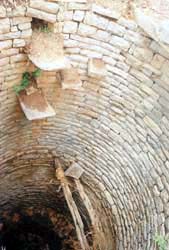
- Majority of wells in both polluted and control village are bore wells.
- All the drinking wells are abandoned due to pollution in distillery effluent
polluted village. In addition, 22 per cent of open wells and 8.8 per cent
of bore wells are abandoned, as it could not be used for irrigation.
- Even with accessibility to irrigation, cropping intensity and irrigation
intensity in distillery effluent polluted village is 174 per cent and 156
per cent respectively which is lower when compared with the control village
(the additional health care expenditure incurred was Rs 1992 per family per
196 per cent and 220 per cent respectively)
- Farmers using poor quality groundwater incurred an irrigation cost of Rs
28.35 per acre inch per which is twice compared to control village (Rs 13)
per acre inch due to increased cost of repairs and maintenance of pumps set
due to corrosion induced by pumping distillery effluent polluted groundwater.
- Application of distillery effluent polluted groundwater for irrigation has
resulted in farmers to incur huge losses in terms of net return per farm (Rs
50, 480) which is less than half of the net return received by farmers in
control village (Rs 137850).
- The farmers applying poor quality groundwater incurred a loss of 5 qtls
of paddy yield when compared with farmers applying good quality water.
- Farmers in DEPA had to incur a considerable amount as irrigation cost which
is about 15 per cent of the total cost of production of paddy where as in
control village only 9 per cent is used as the irrigation cost in total cost
of production.
- Farmers realized net return from sugarcane of Rs 2954 per acre cultivated
using poor quality irrigation water as against Rs 26,249 realized by applying
good quality groundwater.
- The use of polluted groundwater resulted in allergic dermatitis, skin irritation,
vomiting sensation, stomach pain and irritation of eyes. Due to this annum.
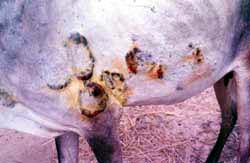 There
was an increase in the rate of cattle mortality due to consumption of polluted
groundwater by cattle. About 17 cattle died in DEPA as against six cattle
in control village. Milk yield reduced by 50 per cent. Due to skin rashes,
edema and dehydration, the farmers had to incur a medical expenditure of Rs
156 per family per month.
There
was an increase in the rate of cattle mortality due to consumption of polluted
groundwater by cattle. About 17 cattle died in DEPA as against six cattle
in control village. Milk yield reduced by 50 per cent. Due to skin rashes,
edema and dehydration, the farmers had to incur a medical expenditure of Rs
156 per family per month.- The repair and maintenance cost of pump set has increased twice to the farmers
whose wells are situated near to lagoon (Rs 2500) as compared to the farmers
away from lagoon.
- Net return per farm for farmers located away from lagoon increased by 35
per cent (Rs 6227) when compared with farmers near the lagoon.
- Irrigation cost reduced with increase in distance from lagoon. Irrigation
cost incurred by farmers closer to lagoon was Rs 219 per farm while it was
Rs 19 for farmers away from lagoon.
- Due to use of polluted groundwater productivity of all crops reduced in
distillery effluent polluted village. There was a 49 per cent decline in sugarcane
yield, 27 per cent in paddy, and 75 per cent reduction in yield of tomato.
- The loss of human labour days due to health damage resulting from distillery
pollution was about 18 days. As a result the farmers incurred an opportunity
cost of Rs 900 per annum.
- Distance from irrigation canal was negatively associated with net return
per rupee of groundwater cost. Thus, as the distance from canal increases
the net returns decreases. This shows that the canal water helps in ameliorating
pollution hazards but not to a significant effect. The electrical conductivity
is also negatively related to net returns showing that as the EC increases
the net returns decreases.
- The farmers using polluted groundwater for irrigation incurs a net loss
of about Rs 19077 per acre of sugar cane production and about Rs 4767 per
acre of paddy production.
Implications
- Polluters pay principle should be used to account the polluters' inaction
in reducing / preventing pollution.
- The Karnataka State Pollution Control Board should enact strict policy framework
to prevent pollution.
- Subsidies should be given to farmers to take up amendments to control pollution
damages. Suitable amendments like application of gypsum, green manure should
be employed to reduce the effect of pollution on soil.
This Research is published in 5th IWMI-TATA Annual Partners' Meet, March 2006.
Click here to Download
this paper, Varuni, C.N., Chandrakanth, M.G., Nagaraj, N. and Srikanthmurthy,
P.S., (2006), Externalities of groundwater contamination due to pollution and
effects on agriculture and health in Karnataka, 5th IWMI-TATA Annual partners'
meet, March 2006

 Riverbeds are source of sand, which is basic
raw material in construction activity. The layer of sand forms the spongy surface,
which enhances groundwater recharge. In recent years due to rapid urbanization
sand has been exploited in unsustainable manner, which has adverse impacts on
riparian areas. In Karnataka Department of Mines and Geology permitted mining
of sand along the riverbed of Uttara Pinakini. But the department could not
strictly monitor the mining of sand as a result sand has been mined more than
permitted level, which has adverse impact on riparian area. Sand mining is done
to a depth of 20 to 30 feet, so the study is undertaken along Uttara Pinakini
to estimate the impact of sand mining. This study estimates the externalities
due to mining on groundwater depletion, which effects the irrigation along the
river stream.
Riverbeds are source of sand, which is basic
raw material in construction activity. The layer of sand forms the spongy surface,
which enhances groundwater recharge. In recent years due to rapid urbanization
sand has been exploited in unsustainable manner, which has adverse impacts on
riparian areas. In Karnataka Department of Mines and Geology permitted mining
of sand along the riverbed of Uttara Pinakini. But the department could not
strictly monitor the mining of sand as a result sand has been mined more than
permitted level, which has adverse impact on riparian area. Sand mining is done
to a depth of 20 to 30 feet, so the study is undertaken along Uttara Pinakini
to estimate the impact of sand mining. This study estimates the externalities
due to mining on groundwater depletion, which effects the irrigation along the
river stream.
 The major source of irrigation is groundwater
in the hard rock areas of Gowribidanur as river flow is seasonal and farmers
depend on borewells, open wells and filter point wells for irrigation. Sand
mining has resulted in groundwater depletion, which increased the well failure
in sand mining area.
The major source of irrigation is groundwater
in the hard rock areas of Gowribidanur as river flow is seasonal and farmers
depend on borewells, open wells and filter point wells for irrigation. Sand
mining has resulted in groundwater depletion, which increased the well failure
in sand mining area.


 During
the grant period covered in this report, study on the effect of groundwater
pollution in irrigated agriculture is. In this study externalities due to use
of polluted groundwater for irrigation are estimated by covering the population
of all the 35 farmers who had irrigation wells which are affected by distillery
effluent pollution in the distillery effluent polluted villages (DEPA), comprising
Geekalli, Golur in Nanjangud taluk. For contrast, a sample of 35 farmers in
Devarasanahalli are covered as control. Major effect of groundwater pollution
is the downward shift in sugarcane area due to pollution to the tune of 60 percent.
In DEPA, all drinking water wells are abandoned and 22 percent of open wells
and eight percent of bore wells are abandoned. Farmers in DEPA (control village)
realized a net return per acre of Rs. 5489 (Rs. 10892), a reduction of 98 percent
due to use of distillery effluent polluted groundwater for irrigation, despite
this water being diluted from the Kabini surface water irrigation. The surface
water irrigation from Kabini is available only for the first six months from
Jan to June.
During
the grant period covered in this report, study on the effect of groundwater
pollution in irrigated agriculture is. In this study externalities due to use
of polluted groundwater for irrigation are estimated by covering the population
of all the 35 farmers who had irrigation wells which are affected by distillery
effluent pollution in the distillery effluent polluted villages (DEPA), comprising
Geekalli, Golur in Nanjangud taluk. For contrast, a sample of 35 farmers in
Devarasanahalli are covered as control. Major effect of groundwater pollution
is the downward shift in sugarcane area due to pollution to the tune of 60 percent.
In DEPA, all drinking water wells are abandoned and 22 percent of open wells
and eight percent of bore wells are abandoned. Farmers in DEPA (control village)
realized a net return per acre of Rs. 5489 (Rs. 10892), a reduction of 98 percent
due to use of distillery effluent polluted groundwater for irrigation, despite
this water being diluted from the Kabini surface water irrigation. The surface
water irrigation from Kabini is available only for the first six months from
Jan to June.
 As
the net return from different crops in DEPA are far lower than in control village,
a few farmers in DEPA searched for new opportunities including off-farm income
by working in the distillery factory realizing Rs 11,142 per family. The off-farm
income was Rs. 3571 in control village. Due to exposure to distillery effluent
pollution of groundwater, an additional Rs 1432 was incurred towards health
expenditure per family per annum in DEPA. The net return per acre for farmers
located closer to (away from) lagoon and canal irrigation area was Rs. 4859
(Rs.6227), a reduction of 22 percent. Similarly the repair charges of pumpset
were Rs. 2500 (Rs. 937), an increase of 167 percent. These are distinct pointers
to the effect of distillery pollution effluents on agriculture. Net loss per
acre of paddy (sugarcane) in DEPA was Rs2656 (Rs. 16840). The DEPA farmers richly
deserve to be compensated for this loss to this extent by taxing the distillery
to the tune of Rupee 1 for every liter of ethyl alcohol produced.
As
the net return from different crops in DEPA are far lower than in control village,
a few farmers in DEPA searched for new opportunities including off-farm income
by working in the distillery factory realizing Rs 11,142 per family. The off-farm
income was Rs. 3571 in control village. Due to exposure to distillery effluent
pollution of groundwater, an additional Rs 1432 was incurred towards health
expenditure per family per annum in DEPA. The net return per acre for farmers
located closer to (away from) lagoon and canal irrigation area was Rs. 4859
(Rs.6227), a reduction of 22 percent. Similarly the repair charges of pumpset
were Rs. 2500 (Rs. 937), an increase of 167 percent. These are distinct pointers
to the effect of distillery pollution effluents on agriculture. Net loss per
acre of paddy (sugarcane) in DEPA was Rs2656 (Rs. 16840). The DEPA farmers richly
deserve to be compensated for this loss to this extent by taxing the distillery
to the tune of Rupee 1 for every liter of ethyl alcohol produced.

 There
was an increase in the rate of cattle mortality due to consumption of polluted
groundwater by cattle. About 17 cattle died in DEPA as against six cattle
in control village. Milk yield reduced by 50 per cent. Due to skin rashes,
edema and dehydration, the farmers had to incur a medical expenditure of Rs
156 per family per month.
There
was an increase in the rate of cattle mortality due to consumption of polluted
groundwater by cattle. About 17 cattle died in DEPA as against six cattle
in control village. Milk yield reduced by 50 per cent. Due to skin rashes,
edema and dehydration, the farmers had to incur a medical expenditure of Rs
156 per family per month.